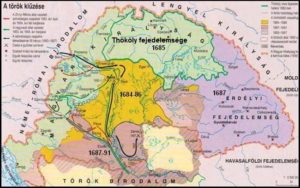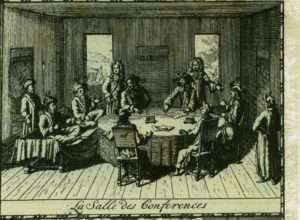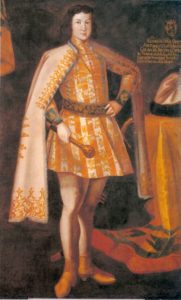26 January 1699 the Peace of Karlóca
On 26 January 1699, the Peace of Karlóca was signed between Emperor Leopold I and Sultan Mustafa II…
This truce closed the Reconquest Wars of Hungary and the 150-year Ottoman occupation of the biggest part of the Kingdom of Hungary was over. Let us take a quick look at these Reconquest Wars.

The „Liberation” (or Reconquest) of Hungary until 1699
In a way, the “liberation” of Hungary was triggered indeed by Prince Thököly Imre. Without him, the Turks could have never besieged Vienna in 1683.
The troops of Duke Charles of Loraine and the Polish King Jan Sobiesky defeated the Ottoman army After the siege of Vienna, the conclusion was very quickly drawn: Hungary must be liberated and the Turks must be dealt with for good. The Habsburgs could not have afforded a new Turk attack or a new Hungarian uprising. Besides, there would be no more Polish help in case of a new Turkish siege.

The Habsburgs had failed to liberate Hungary in 1664 because it was not an Imperial interest at that time, but now they had to attack if they wanted to survive the next Turkish or Hungarian attack. Thus, Pope Innocent XI organized the Holy League in 1684 with the Papal States, the Holy Roman Empire, Poland, Venice, and later on Russia. It was called a Crusade and many soldiers, mercenaries, and nobles joined it from all countries of Europe. These states agreed that they would fight the Ottomans on their territories and would not make a truce with the enemy without the others.

On the lands of Hungary, the armies of the Habsburg Empire gradually pushed back the Ottomans. Of course, the Hungarian Hajdús and all sorts of dismissed castle warriors from the Borderland and other soldiers from all over Hungary were of great help to the Crusaders – not only because of their special warfare but also because they knew the land like the back of their hands. Almost all the soldiers of Thököly deserted their leader and joined the Crusaders. For the next 15 years, the Turks lost all decisive battles due to the disadvantages of their old-fashioned army.

See the battles in 1683: Párkány, Esztergom; 1685 Érsekújvár; 1686 Buda; 1687 Nagyharsány; the capture of Transylvania; 1688 Nándorfehérvár (Belgrade). The surrounded fortresses of Kanizsa, Székesfehérvár, Eger, Szigetvár, and finally Várad opened their gates one after the other.

The Turks fought back in 1690, and led by the excellent leader, Grand Vizier Köprülü (Kara) Mustafa, they took back Nándorfehérvár, Lippa, and Törökkanizsa. The Sultan was encouraged by the French King Louis XIV in his actions. Yet, the Grand Vizier was defeated and lost his life in the Battle of Szalánkemén in 1691. The war was going on between 1691 and 1697 with victories and losses. (1695: the taking of Gyula; the defeat at Lugos and Hetény a year later.) Prince Eugene of Savoy took the leadership in 1697 and after defeating the last rebels of Thököly at Hegyalja, he won a decisive victory at Zenta.

The „Liberation of Hungary” was so devastating that contemporary sources estimate the mercenaries’ destruction of the recaptured places worse than many years of Turkish rule. As the Turks suffered further defeats in Poland, Venice, and Russia, the Ottoman Empire was exhausted after 15 years of fighting.
You can watch a video about the “reconquest” war of Hungary on my page:

On January 27, 1698, the Ottoman supreme leaders decided to present a peace proposal to the leaders of the Habsburg Empire, with the intercession of William of Orange, King of England and Governor of the Low Countries. At that time, the Turks imagined that the border would be drawn at the Maros River, leaving Transylvania in their hands and that the fortress of Pétervárad would be destroyed by the imperialists. In return, they would have given other fortresses in Bosnia to Leopold.

England willingly undertook to intervene, needing the support of the armies of the Holy Roman Emperor Leopold I against France, the latter also exhausted to the extreme in the double (anti-Turkish and anti-French) war. In the fall of 1697, the Treaty of Rijswijk was signed with King Louis XIV of France, and all that remained was to end the Ottoman war.

The British envoy sent the Ottoman peace terms to Vienna, but in April Leopold replied that he would not negotiate without prior conditions, but only based on the status quo. He also saw the need to involve the members of the Holy League, which was one of the conditions of the alliance.
To put pressure on the emperor, the Turks launched an attack in the spring of 1698.
To put pressure on the emperor, the Turks launched an attack in the spring of 1698.

Photo: Lánczi Imre
They captured the castle of Solymos, but after that, they only made small raids. The Grand Vizier Köprülü Hussein regularly evaded the soldiers of Prince Eugene Savoy, showing that he did not want to conquer, but only to improve the peace conditions. Prince Eugene understood this, and in September he retreated from Temesköz Region behind the Tisza River and ended the campaign for his part.

Vienna and Debrecen were mentioned in the choice of the place of negotiation, but the Sublime Porta said they would not accept a settlement north of the Danube. It was how Karlóca (Karlowith, Karlovac) was chosen in the Szerémség (Sirmium) area. The village was in ruins, so a tent camp was set up next to it for the many envoys, escorts, servants, and soldiers. The ambassadors of the Holy League were given individual wooden huts.

On October 14, the representatives of the League arrived by ship in Pétervárad and the Turks in Belgrade. After four days, the parties declared a truce and all hostilities were forbidden under penalty of death.

Photo: Patrióta Európa Mozgalom
Emperor Leopold was represented by Count Wolfgang of Öttingen, a Privy Councillor who was a complete amateur in Turkish affairs. He did not speak Italian, and the negotiations were conducted in that language. General Leopold Schlick appeared alongside Öttingen as a military expert. The task of demarcating the border was entrusted to the renowned military engineer, Colonel Luigi Ferdinando Marsigli. Talman, the interpreter, and a secretary were also part of the delegation. Since Leopold wanted to conclude the peace treaty in his capacity as a German-Roman monarch, he did not feel bound by the law of 1681, which stipulated that a representative of the Hungarian Estates had to be present at the negotiations.

King Frederick Augustus of Poland was represented by Stanislaw Malachowsky, Palatine of Poznan, Tsar Peter I of Russia by Prokop Bogdanovich Voznyicin, and the Doge of Venice by Carlo Ruzzini. The Porta delegated Rami Mehmed, the head of the Foreign Office, and Alexander Maurocordato, the interpreter. The English ambassador in Constantinople, William Paget, and the Dutchman Jacob Colyer mediated.

The Sultan’s representatives negotiated separately with the envoys of each Christian country, and mediators tried to soften the often sharp disagreements. In the end, the peace treaty was not a single document, but each country signed an individual treaty. The first meeting began on November 13, and the parties met 36 more times. They met roughly from 10 a.m. to 2:30 p.m. each time.

Emperor Leopold’s envoys also demanded the Temesköz region and Mehmed Rami demanded Transylvania or an annual tribute in return. In the end, the status quo was maintained. Temesko remained with the Sultan, Transylvania with Leopold, and the castles of Becskerek, Kiskanizsa, Lugos, Karánsebes, Lippa, and Csanád were ordered to be demolished. The rivers Maros and Tisza became freely navigable for both sides.

The part of Szerémség (Sirmium) east of the Boszut River also remained in Turkish hands. Porta undertook to resettle the Hungarian rebels (mainly Thököly and his companions) in places far from the border. This is how the Kuruc ended up in Nicomedia in Asia Minor. The situation with the Poles was more difficult, but eventually, the Turks gave up Podolia and with it the important castle of Kameniec and Ukraine. The Russians were not very eager to make peace, so only a two-year truce was established with them.

Since the dispute with Venice was protracted, on January 10, Lord Paget, tired of the fruitless disputes, gave the parties 16 days to decide. This had an effect. Venice took the Dalmatian coast up to Ragusa, the occupied Greek islands, and the Morea, the Peloponnese peninsula. The Turks had to destroy the Dardanelles castles in exchange for Venice giving up the island of Lepanto.

On January 26, 1699, the envoys finally entered the negotiating tent, where the draft treaty(s) were read, and at a quarter to 12, all signed the documents. The four sides of the tent were then opened, symbolically letting the wind carry the news of peace. Soon the envoys were on their way so that their rulers could sign the treaty.

Hungary, whose representatives were not allowed to take part in the negotiations, but which had mobilized enormous financial and human resources to expel the Turks, became a permanent part of the Habsburg Empire. The Hungarians had no say in their fate; it was decided sine nobis, de nobis (without us, but because of us). At the same time, a long period of almost 200 years of almost constant wars, destruction, and material and human sacrifices came to an end, and the central part of the country was liberated from the Ottomans. Reconstruction and peaceful productive work could begin.

The Habsburgs were ready to turn the Hungarian Kingdom into their hereditary colony and only the War of Independence of Prince Rákóczi Ferenc II, which started in 1703 and lasted until 1711, could stop them. The Temesköz region returned to Hungary only during the war between 1716 and 1718. And the hostilities did not stop for a long time.
The Ottoman wars after the Treaty of Karlóca
As we said, after Prince Rákóczi’s War of Independence, the Habsburgs recaptured the remaining Turkish lands near Temesvár (Timisoara) between 1716 and 18. They also occupied the northern Balkan parts of the Ottoman Empire and Wallachia. One-third of the Habsburg army in these wars consisted of Hungarian troops.

There was another sad event in 1717 when Prince Rákóczi sent Esterházy Antal to Moldavia to ally with the Crimean Tatars and to restart the Hungarian War of Independence by attacking Transylvania. Unfortunately, the small rebel unit of Hungarians could not control the Tatars, who began looting and burning. After plundering the lands around Beszterce, they attacked the town of Szék, killing 90% of the population.

The locals commemorate the massacre every year on August 24th. The Habsburgs did not let the Hungarian soldiers defend themselves against the invaders, fearing a new freedom struggle, so the Tatars plundered and destroyed freely in Transylvania for a long time. When they invaded Eastern Hungary, the Habsburgs reluctantly let the Hungarians fight against them. They were able to free many thousands of prisoners, but northern Transylvania was already devastated. This last war had largely contributed to the profound ethnic change of Northern Transylvania. It was the last and largest Tatar invasion there, with only a few smaller raids later.

The next war of the Habsburgs against the Ottoman Empire was between 1736-39, but it was rather unlucky because they lost the newly occupied lands despite the Russian help. The new border became the line of the Danube River. Less than 15,000 Hungarian soldiers took part in this war. The third – and last – war took place between 1787 and 1791 when Austria again joined forces with the Russians. There were 50,000 Hungarian troops included in the huge imperial army led by Emperor Joseph II. The war had an unfortunate beginning and there were great losses. The Turks made incursions into Hungarian territory, but these were only the usual raids.

Belgrade was taken in October 1789, but the Emperor was about to die. His successor, Leopold II, made peace with the Turks and allied with them against the Prussians in 1791. According to this treaty, Austria ceded Belgrade to the Turks. This was the treaty that ended forever the four-and-a-half centuries of wars between the Turks and the Hungarians if we count the hostilities since the first clashes between the Ottomans and the troops of King Lajos I of Hungary in 1366.
Source: partly from Szibler Gábor

Dear Readers, I can only make this content available through small donations or by selling my books or T-shirts.
If you like my writings, please feel free to support me with a coffee here:
You can check out my books on Amazon or Draft2Digital, they are available in hardcover, paperback, or ebook:
https://www.amazon.com/dp/198020490X
or at https://books2read.com/b/boYd81


My work can also be followed and supported on Patreon: Become a Patron!http://Become a Patron!


https://hungarianottomanwars.myspreadshop.com/

https://hungarianottomanwars.myspreadshop.com/all


